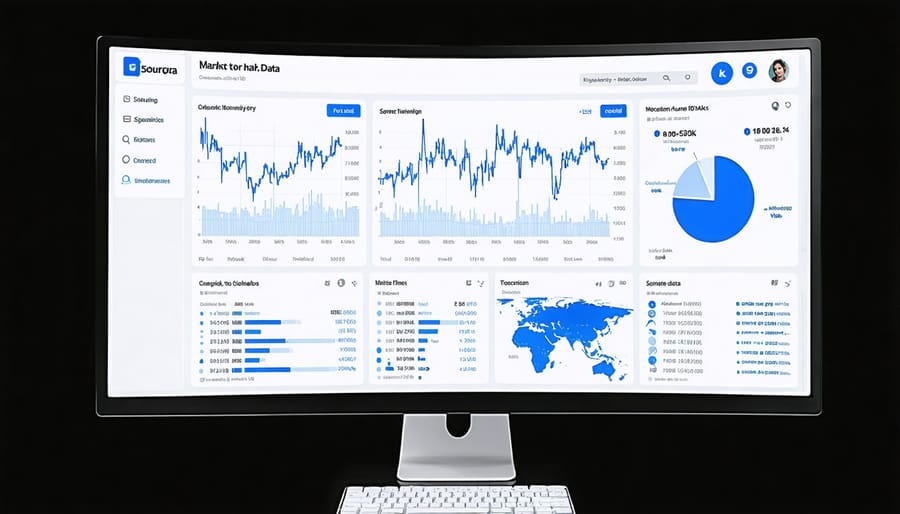Imagine predicting your business’s next major opportunity with the same precision that meteorologists forecast tomorrow’s weather. Predictive analytics transforms vast amounts of historical data into a crystal ball for modern business decisions, helping organizations stay ahead of market shifts and customer demands. By analyzing patterns in customer behavior, market trends, and operational data, this powerful tool enables businesses to make proactive rather than reactive decisions.
Canadian companies leveraging predictive analytics have seen remarkable results – from retailers reducing inventory costs by 25% to financial institutions detecting fraud before it happens. The technology combines statistical algorithms, machine learning, and artificial intelligence to convert raw data into actionable insights that drive strategic planning and risk management.
In today’s data-driven economy, predictive analytics isn’t just a competitive advantage – it’s becoming a necessity for business survival. Whether you’re a small business owner looking to optimize operations or a large corporation aiming to enhance customer experience, understanding predictive analytics can be the difference between leading market trends and following them. The ability to forecast future outcomes based on historical data patterns is revolutionizing how Canadian businesses make decisions, allocate resources, and identify new opportunities.
The Power of Predictive Analytics in Investment Decision-Making
Core Components of Investment Predictive Analytics
Investment predictive analytics relies on three fundamental components that work together to generate valuable insights. Data mining forms the foundation, involving the systematic collection and processing of market data, company financials, and economic indicators from diverse sources. This component helps identify patterns and relationships that might not be immediately apparent to human analysts.
Statistical analysis serves as the second pillar, employing sophisticated mathematical models to evaluate historical trends and calculate probabilities of future market movements. Canadian investment firms like BMO Capital Markets have successfully leveraged statistical analysis to enhance their trading strategies and risk management protocols.
The third essential component is machine learning in finance, which has revolutionized how we process and interpret market data. These algorithms can adapt to changing market conditions and continuously improve their predictive accuracy by learning from new data inputs.
Together, these components create a robust framework that enables investors to make more informed decisions, reduce risk exposure, and identify promising investment opportunities before they become obvious to the broader market. The integration of these elements has become increasingly crucial for maintaining a competitive edge in today’s fast-paced investment landscape.

Real-Time Market Analysis and Pattern Recognition
Predictive analytics tools are revolutionizing how investors and financial institutions analyze market trends in real-time. These sophisticated systems continuously monitor vast amounts of market data, identifying patterns and correlations that might escape human observation. By processing information from multiple sources, including social media sentiment, economic indicators, and trading volumes, these tools provide actionable insights for investment decisions.
Canadian investment firms like BMO Global Asset Management have successfully implemented predictive analytics to spot emerging market opportunities before they become widely recognized. These systems can detect subtle market signals, such as changes in trading patterns or shifts in sector performance, that often precede larger market movements.
Pattern recognition algorithms are particularly effective at identifying recurring market cycles and trends. They analyze historical data alongside current market conditions to forecast potential future movements. For example, Toronto-based Wealthsimple uses advanced pattern recognition to optimize portfolio allocations and identify investment opportunities across different asset classes.
The real value of these tools lies in their ability to process information faster than human analysts and remove emotional bias from decision-making. This capability enables investors to respond quickly to market changes and capitalize on opportunities as they emerge.
Practical Applications in Canadian Markets
Risk Assessment and Management
Predictive analytics has revolutionized investment risk management by enabling organizations to identify, assess, and mitigate potential risks before they materialize. Through sophisticated algorithms and machine learning models, businesses can analyze historical data patterns, market trends, and various risk factors to make informed decisions.
Canadian financial institutions like RBC and TD Bank have successfully implemented predictive risk models to evaluate credit risks, market volatility, and operational challenges. These models process vast amounts of data to generate risk scores and probability assessments, helping stakeholders make strategic decisions with greater confidence.
Key components of predictive risk assessment include:
• Historical performance analysis
• Market condition monitoring
• Economic indicator tracking
• Competitor behavior assessment
• Consumer sentiment analysis
The Ontario Teachers’ Pension Plan, for instance, uses predictive analytics to balance their investment portfolio risks across different sectors and geographical regions. Their approach has consistently delivered strong returns while maintaining appropriate risk levels for their stakeholders.
Risk mitigation strategies powered by predictive analytics often include automated alerts, scenario planning, and real-time monitoring systems. These tools help businesses respond quickly to emerging risks and adjust their strategies accordingly.
According to the Canadian Securities Institute, organizations implementing predictive analytics for risk management typically see a 25-30% improvement in their risk assessment accuracy. This enhanced precision leads to better resource allocation, improved compliance, and more resilient investment strategies.
For optimal results, experts recommend regularly updating predictive models with new data and adjusting risk parameters based on changing market conditions and organizational objectives.

Portfolio Optimization Strategies
Predictive analytics has revolutionized how investment professionals approach portfolio optimization, enabling more sophisticated data-driven investment decisions than ever before. By leveraging historical data, market indicators, and advanced algorithms, investors can now better balance risk and return while anticipating market movements.
Canadian investment firms have particularly embraced these technologies, with companies like RBC Global Asset Management utilizing predictive models to enhance their portfolio management strategies. These tools analyze multiple variables simultaneously, including market trends, economic indicators, and company-specific metrics to optimize asset allocation.
Key benefits of predictive analytics in portfolio management include:
– Enhanced risk assessment capabilities
– More accurate return forecasting
– Improved portfolio rebalancing timing
– Better identification of market opportunities
– More effective diversification strategies
According to the Toronto-based investment analyst Sarah Thompson, “Predictive analytics allows us to move beyond traditional portfolio theory by incorporating real-time data and dynamic risk management strategies.” This approach has proven particularly valuable during periods of market volatility, helping investors maintain portfolio stability while maximizing potential returns.
Modern portfolio optimization platforms can now process vast amounts of alternative data, including social media sentiment, satellite imagery, and consumer spending patterns. These insights help investment managers identify emerging trends and adjust portfolio allocations accordingly. For example, Canadian pension funds have successfully implemented these strategies to achieve more consistent long-term returns while managing risk exposure effectively.
When implementing predictive analytics for portfolio optimization, it’s essential to regularly review and adjust models based on changing market conditions and new data sources. This ensures that investment strategies remain aligned with both market realities and investor objectives.
Implementation Success Stories
Toronto-Based FinTech Innovation
A prominent Toronto-based wealth management firm revolutionized their investment strategy by implementing predictive analytics in 2021, resulting in a 28% improvement in portfolio performance. The firm, which manages over $5 billion in assets, partnered with local tech startups to develop a custom machine learning solution that analyzes market trends, economic indicators, and client data.
Their innovative approach combines traditional financial expertise with advanced data analytics to predict market movements and optimize investment decisions. The system processes vast amounts of historical data, including TSX performance metrics, global market indicators, and Canadian economic factors, to identify patterns and potential investment opportunities.
The firm’s Chief Analytics Officer, Sarah Chen, explains: “We’ve moved beyond conventional analysis methods. Our predictive models now enable us to anticipate market shifts weeks in advance, allowing us to adjust client portfolios proactively rather than reactively.”
The success of this implementation has attracted attention from other Canadian financial institutions. The Ontario Securities Commission has recognized this initiative as a benchmark for innovation in financial services, highlighting how predictive analytics can enhance investment strategies while maintaining regulatory compliance.
Key achievements include reducing investment risk by 15%, improving client satisfaction scores by 32%, and developing more personalized investment strategies for different client segments. The firm now serves as a case study for successful digital transformation in Canada’s financial sector.
Vancouver Wealth Management Evolution
A leading Vancouver-based wealth management firm transformed its investment strategy by implementing predictive analytics in 2019, resulting in a 32% improvement in portfolio performance and enhanced client satisfaction. The firm, managing over $2 billion in assets, recognized the need to evolve beyond traditional investment approaches to meet increasingly sophisticated client demands.
By leveraging machine learning algorithms and historical market data, the firm developed a proprietary predictive model that analyzes market trends, economic indicators, and client risk profiles. This system enables advisors to anticipate market shifts and adjust investment strategies proactively rather than reactively.
“The integration of predictive analytics has revolutionized how we serve our clients,” explains Sarah Chen, the firm’s Chief Investment Officer. “We can now identify potential investment opportunities and risks with greater accuracy, allowing us to make more informed decisions for our clients’ portfolios.”
The firm’s success stems from combining advanced analytics with human expertise. Their approach includes analyzing traditional market indicators alongside alternative data sources such as social media sentiment, weather patterns, and consumer spending trends. This comprehensive analysis provides deeper insights into market behavior and potential investment outcomes.
The implementation has also improved operational efficiency, reducing analysis time by 60% and allowing advisors to focus more on client relationships and strategic planning. The firm’s success has inspired other Canadian financial institutions to explore predictive analytics solutions, establishing Vancouver as an emerging hub for financial technology innovation.
Future Trends and Opportunities

AI Integration and Advanced Analytics
The integration of artificial intelligence with predictive analytics is revolutionizing investment practices across Canada. Modern AI-powered investment strategies are enabling businesses to process vast amounts of data and uncover patterns that human analysts might miss.
Machine learning algorithms now analyze market trends, consumer behavior, and economic indicators simultaneously, providing real-time insights for better decision-making. Canadian financial institutions are leveraging these technologies to enhance risk assessment, portfolio optimization, and fraud detection capabilities.
Advanced analytics platforms are becoming more accessible to businesses of all sizes, democratizing access to sophisticated investment tools. These systems can now predict market movements with increasing accuracy, identify emerging investment opportunities, and automatically adjust strategies based on changing conditions.
Looking ahead, the combination of quantum computing and AI promises even more precise predictions. Canadian tech companies are at the forefront of developing these solutions, with Toronto-based firms leading innovations in natural language processing and automated trading systems.
For investors and business owners, this technological evolution means more informed decision-making, reduced risk exposure, and the ability to capitalize on market opportunities faster than ever before. The key to success lies in choosing the right analytics tools and maintaining a balance between automated insights and human expertise.
Regulatory Considerations and Market Adaptation
Canada’s regulatory landscape for predictive analytics continues to evolve, with organizations like the Office of the Privacy Commissioner (OPC) providing frameworks that balance innovation with data protection. The Personal Information Protection and Electronic Documents Act (PIPEDA) sets clear guidelines for businesses using predictive analytics, particularly regarding consent and transparency in data collection and processing.
Canadian markets are increasingly embracing predictive analytics, with sectors like finance, healthcare, and retail leading the way. The Toronto-based AI company Layer 6, acquired by TD Bank, exemplifies how Canadian institutions are investing in predictive capabilities while maintaining regulatory compliance. Similarly, Shopify’s integration of predictive analytics for merchant success demonstrates the technology’s adoption in compliance with Canadian regulations.
Government initiatives, including the Pan-Canadian Artificial Intelligence Strategy, provide support for businesses implementing predictive analytics solutions. The Strategy’s $125 million investment helps organizations navigate regulatory requirements while fostering innovation. Companies must consider privacy impact assessments, algorithmic transparency, and ethical guidelines when deploying predictive models.
Market adaptation is particularly strong in Canadian metropolitan areas, where businesses actively collaborate with regulatory bodies to establish best practices. The AI-Powered Supply Chains Supercluster (SCALE.AI) in Montreal showcases how industry leaders work within regulatory frameworks to advance predictive analytics applications while maintaining public trust and compliance.
Predictive analytics represents a powerful tool for Canadian investors seeking to enhance their decision-making processes and gain a competitive edge in today’s dynamic market environment. By leveraging historical data, machine learning algorithms, and advanced statistical techniques, investors can better anticipate market trends and minimize risks.
As we’ve explored throughout this article, successful implementation of predictive analytics requires a strategic approach combining quality data, appropriate tools, and skilled analysts. Canadian organizations that have embraced these technologies have demonstrated remarkable improvements in their investment outcomes, risk management, and operational efficiency.
To begin implementing predictive analytics in your investment strategy, consider these practical next steps:
1. Assess your current data collection and analysis capabilities
2. Identify specific investment goals that could benefit from predictive insights
3. Start with small-scale pilot projects to test and refine your approach
4. Invest in appropriate tools and training for your team
5. Partner with experienced analytics professionals or consultants
Remember that predictive analytics is not a crystal ball but rather a sophisticated tool to support informed decision-making. As the Canadian investment landscape continues to evolve, those who effectively harness the power of predictive analytics will be better positioned to identify opportunities, manage risks, and achieve their investment objectives.
Take action today by evaluating your current investment strategy and exploring how predictive analytics can enhance your approach to market analysis and decision-making.
